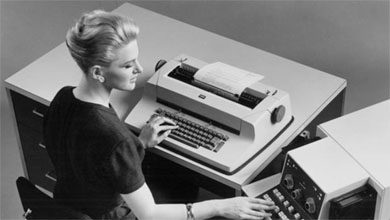Have You Seen a Typewriter, Mom?
It sounds odd to talk about a typewriter in the current digital world dominated by computers. And most tweens and teens would not have even seen a typewriter.
But tech major IBM is commemorating the birth of its Selectric typewriter which turns 50 on July 31. The Selectric’s half-century birthday coincides with IBM’s Centennial year and the release of a new U.S. postage stamp honoring the Selectric as an icon of design.
The IBM Selectric made its debut on July 31, 1961, and remained the typewriter found on most office desks until the brand was retired 25 years later, in 1986.
[ Also Read: Bharti Airtel Prefers IBM; Ignores Indian Tech Firms ]With 2,800 parts, many designed from scratch, it was a major undertaking even for IBM, which had been in the typewriter business since the 1930s. The Selectric marked a radical change from previous typewriter designs, and it took IBM seven years to work out the manufacturing and design challenges before it went on sale.
The Selectric typewriter, according to IBM, was a game-changer in many ways. Its “golf ball” head allowed typists’ fingers to fly across the keyboard at unprecedented speed. An expert typist could clock 90 words per minute versus 50 with a traditional electric typewriter, claims IBM.
The golf ball moved across the page, making it the first typewriter to eliminate carriage return and reducing its footprint on office desks. Interchangeable golf balls equipped with different fonts, italics, scientific notations and other languages could easily be swapped in.
[ Also Read: Knowledge Stories for Children – Ten Tales ]With magnetic tape for storing characters added in 1964, the Selectric became the first (albeit analog) word-processor device, says the company.
The Selectric also formed the basis for early computer terminals and paved the way for keyboards to emerge as the primary way for people to interact with computers, as opposed to pressing buttons or levers.
A modified Selectric could be plugged into IBM’s System/360 computer, enabling engineers and researchers to interact with their computers in new ways.
[ Also Read: Look, How Humans Talk with the Objects ]“Nearly two decades before computers were introduced, the Selectric laid the foundation for word-processing applications that boosted efficiency and productivity, and it inspired many user-friendly features in computers that we take for granted today,” said Linda Sanford, senior VP, Enterprise Transformation, IBM, who was a development engineer on the Selectric.
The Selectric’s curvaceous form was a hallmark of IBM’s industrial design and product innovation. It was created by Eliot Noyes, the famed architect and industrial designer who served as IBM’s consulting designer for 21 years.
The Selectric is featured in the new “Pioneers of American Industrial Design” stamp series from the U.S. Postal Service, which cites Noyes as among 12 important industrial designers who helped shape the look of everyday American life in the 20th century. The stamp displays Noyes’ name and an image of the typewriter.
Photo courtesy: IBM





